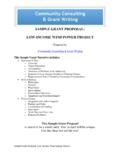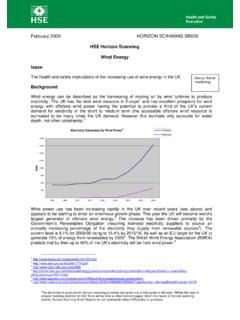Transcription of Acoustic Ecology Institute Fact Sheet: Wind Energy Noise ...
1 Acoustic Ecology Institute : wind Turbine Noise fact sheet Page 1 of 8 45 Cougar Canyon Santa Fe NM 87508 Acoustic Ecology Institute fact sheet : wind Energy Noise Impacts Excerpted from a 25-page AEI Special Report: wind Energy Noise Impacts, available at: Visit this page for links to sources mentioned below Introduction This AEI fact sheet is not intended to over-emphasize Noise complaints, but rather to provide information that can foster informed conversation about any specific wind farm proposal. As you'll read below, it appears that Noise can be a significant issue in at least some situations when turbines are within about a half mile of homes, with impacts occasionally occurring up to a mile away.
2 Some acousticians and health professionals are encouraging setbacks of miles (roughly 2km) or even a bit more. In the US, it is quite common to have setbacks defined as a multiple of turbine height; for example, 5 times the turbine height from a home (which would equate to 500m for a 100m turbine). It appears to AEI that a half-mile (800m) setback is marginally acceptable if the goal is to minimize impacts on residents, though we would prefer a one-mile ( ) setback, which would offer near assurance of avoiding Noise issues. Each proposed wind farm site is unique and must be evaluated based on local topographic, atmospheric, and land use patterns. Prevailing wind direction is a key factor, as is topography.
3 A recent UK government survey suggests that about 20% of wind farms tend to generate Noise complaints; the question is, what are the factors in those wind farms that may be problematic, and how can we avoid replicating these situations elsewhere? Noise impacts are not necessarily deal-killers for wind Energy , as long as developers are honest about what is likely to be heard and continue to work diligently to investigate the aspects of wind turbine Noise that are still not fully understood. The Altamont wind Farm in California, built on a major raptor flyway in the early years of industrial wind development, has continued to be a poster child for the bird-killing power of wind turbines, despite widespread understanding that it was an exceedingly bad siting decision, one not likely to be repeated.
4 Similarly, many Noise complaints today seem to be coming from people whose homes are on the near edge of fairly lax setback guidelines (within 1500 feet in many cases). Will a few ill-considered siting choices similarly poison attitudes about Noise issues? Resistance to wind farms is often belittled as NIMBY-ism (Not In My Backyard); but at the same time, proponents often slip into oversimplified WARYDU rhetoric (We Are Right; You Don't Understand). If we are to forge a reliable Energy future that is respectful of both the environment and the rights of neighbors, we'll need to move past knee-jerk reactions on both sides, and develop best practices that can ensure that the landscape and local residents don't become long-term casualties of today's "Klondike wind Rush.
5 " Acoustic Ecology Institute : wind Turbine Noise fact sheet Page 2 of 8 How Noisy Are wind Turbines? The US National wind Coordinating Collaborative, a multi-stakeholder group that aims to facilitate wind development, summarizes the situation in fairly straightforward terms: By and large, those affected by the Noise generated by wind turbines live within a few miles of a large wind power plant or within several hundred feet of a small plant or individual turbine. Although the Noise at these distances is not great, it nevertheless is sufficient to be heard indoors and may be especially disturbing in the middle of the night when traffic and household sounds are diminished.
6 In a similar vein, the American wind Energy Association's fact sheet on Noise notes that "Today, an operating wind farm at a distance of 750 to 1,000 feet is no noisier than a kitchen refrigerator." This raises a question: how many of us sleep in the kitchen? The bottom line is that most modern industrial wind turbines are designed to keep Noise levels at or below 45dB at 1000 feet (350 meters), which should drop to 35-40dB at a bit over a half mile (1000m); commercial turbines are quite often built this close to homes. Some are rated at lower sound levels. However, as is noted below, atmospheric conditions can wreak havoc with nice clean sound propagation models, especially at night.
7 And, as turbines get bigger, their Noise can be deceptively hard to predict; certainly, they can be quieter at their bases than some distance away, and temperature inversions, wind layers, and other atmospheric effects can lead to surprisingly distant sound impacts. It appears that turbine Noise travels farther in calm night air; one widely-respected study (van den Berg, see below) found that sound levels were 5-15dB louder than predicted in some night-time atmospheric conditions, and noted that residents as far as away were disturbed by Noise . In nearly all cases, those downwind bear the brunt of the sound; if you live upwind of a wind farm, Noise problems will likely be far less severe.
8 It is important to recognize that night-time ambient Noise levels in rural areas are often 35dB or lower; so, it is not that hard for wind farms to become a new and dominant Acoustic presence. All too often, wind developers tell local planning boards that the turbines will be inaudible, which is rarely the case. Similarly, some investigations of Noise complaints come to the conclusion that anomalously high Noise levels occur so infrequently that they are insignificant. But if temperature inversions or other atmospheric stability effects that cause excessive Noise occur just 10% of the nights, that means that nearby residents may find their sleep disturbed 35 nights a year. Is this insignificant?
9 Such questions need to be considered directly, not shunted aside. While in many situations, the sound from turbines is drowned out by nearby wind Noise , or is perceived as a gentle whooshing Noise that is quite easy to accommodate, in some wind or atmospheric conditions, a pulsing Noise can arise, which is much harder to ignore or acclimate to, making it a major source of complaints. Perceptually, the problem is that any pulsed or irregular sound (this rhythmic thumping tends to wax and wane over the course of a night) will tend to cause more disturbance. These pulses, sometimes termed Amplitude Modulation, are usually loudest in one or two specific directions, depending on the wind direction.
10 When considering Noise predictions, beware of overly simplistic comparisons of sound levels. Acousticians, as well as advocacy organizations on both sides of the issue, will often say a turbine s Noise is equal to or the same as a familiar sound (distant traffic, quiet conversation), or is twice as loud as something else (perhaps the background Noise level). While these comparisons have a basis in physics and our anatomical responses, the fact is that humans do not perceive and compare sounds as neatly as they perceive, say, height or weight. Certainly, twice as loud is an indefinite value for most people; and, equivalent dB value sounds are experienced very differently depending on the nature of the sound itself and the situation in which we hear it.






